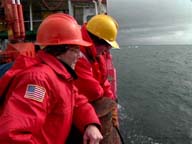
Biography of Robin Ross
UCSB researcher Robin Ross is a member of the LTER team we'll be encountering throughout
the live programs. She helped create and review the "Phytoplankton See the Light"
and other Activities in the Teacher's Guide, and LFA 2 thanks her, and husband and
co-worker Langdon Quetin, very sincerely.

LTER PI Robin Ross monitors operations on board Polar Duke.
Our individual scientific mission.
The Palmer LTER (Long-Term Ecological Research) program was established in 1990 to
study the polar marine ecosystem in the area west of the Antarctic Peninsula. In
the Southern Ocean one of the dominant physical factors structuring the ecosystem
is the annual advance and retreat of sea ice, one of the largest physical phenomena in the
world's oceans.
The Palmer LTER includes researchers working on many different aspects of this ecosystem,
from the growth and movement of sea ice to seabird reproduction. With my colleague
and husband, Langdon Quetin, I am responsible for research on 'prey'. Prey for the upper level predators like penguins includes large zooplankton (unable to swim against
currents) and micronekton (small animals able to swim against some currents). In
the Southern Ocean, Antarctic krill is one of the most important prey items. In fact
it is a keystone species, the organism upon which many Antarctic predators depend. The
analogy is to building an arch with a keystone in the center of the arch which keeps
the entire structure from collapsing. Our working hypotheses center on the effects
of physical factors (e.g. sea ice and oceanic circulation) on zooplankton and krill distributions,
abundances, and "recruitment" within the LTER region. All krill born in one summer
belong to a year class, similar to the year of a group of students when they graduate from high school. To us, "recruitment" refers to how successful a particular
year's "class" is after their first year of life: a strong year class is one with
many survivors to age 1, and a weak year class would have few survivors to year 1.
One major interest is to work with our colleagues to look at the effect of the year-to-year
changes we see in zooplankton community composition and abundance (including krill)
both up and down the food web, i.e. on the food supply of the krill (primarily phytoplankton), and on their predators (penguins).
My training was first as a biologist (undergraduate at University of Rochester) where
I took courses not only in biology, but also in chemistry, physics, calculus and
geology! That broad science background was essential when I decided to go to graduate
school in oceanography. At the University of Washington (Seattle) where I completed both
a Master's and a Ph. D. in Biological Oceanography (1971, 1979), the core curriculum
included classes in physical, chemical and geological oceanography. The concept of
broadening the horizons of all aspiring oceanographers and educating them in other aspects
of oceanography besides their own specialty was important, and provided an appreciation
of other disciplines. As a result we learned to interact knowledgeably with our colleagues, a skill essential to multi-disciplinary teams asking questions about
how entire ecosystems function.
Some personal background:
I lived on a farm in New England and close to the ocean for the first 18 years of
my life. Although I don't remember verbalizing my feelings at the time, I think that
as the chores on the farm changed with the seasons, I gained an appreciation of the
variation possible within the fixed cycle of spring-summer-fall-winter. All through my
early education I thought I would like to work in the field of biology, but my goals
ranged from raising horses to being a medical technician. In high school my biology
and chemistry teachers made the classes fun -- learning what was really in the pond waters
we were swimming in and learning chemical tricks to make mixtures magically change
color for a school assembly!
I liked biology so much that I even went to a six-week summer school in advanced biology
where high school juniors from all over the state gathered to spend most of the morning
listening to a fascinating teacher and most of the afternoon doing hands-on experiments in the laboratory.
Choosing to specialize in oceanography after I completed my undergraduate education
was an easy choice -- combining my love of the ocean and my interest in biology.
But, why Antarctica and why krill? For my Ph. D. I worked on a smaller close relative
of Antarctic krill that lives in the waters of the Pacific North West -- I liked the way
it swam, and I was curious about its life cycle and what sorts of adaptations this
euphausiid (the name of the group of shrimp-like animals that includes Antarctic
krill) had to its environment. One of the things my experiments showed was that this smaller
euphausiid released several batches of eggs each spring whereas before everyone thought
they just released one batch. I wondered if all euphausiids were the same, so when
the opportunity came up to write a proposal to conduct research in the Antarctic I
went for it!





![]()